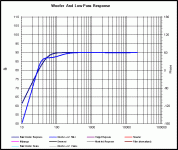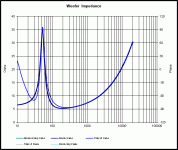Sure there is. Church organ CDs, recording studio mistakes, etc etc.
I have a spectrum analysis of a close-mic'd kick drum somewhere. 16Hz is -3dB on 32Hz.
Chris
Always thought cd was 20hz to 20khz. Assuming you're right, there may be the odd cd that goes below 20hz. Not that that means anything because it depends how loud it's recorded at that low frequency, how loud the person is listening, and also, the port isn't brickwalled at 20hz so does offer some protection below that frequency.
Subjectively I don't think it would make any difference. I can't even imagine how many ported speakers there are out there tuned much higher than 20hz and yet still have tight bass (the last two I built a perfect examples for me, and i'm a big fan of sealed boxes)
As I said before my tv speakers are tuned to 18hz and the bass is just as tight as when they were a sealed box. The proof in the pudding is in the eating, as they say.
Those Marantz multi-ways probably employed Woofers with very different Thiele-Small parameters, housed in Reflex boxes tuned much higher (I'd guess around 40Hz).
Bottom line: you shouldn't automatically assume that all bass-reflex alignments sound the same ;-)
I don’t think I suggested that all BR alignments sound ed the same, some well engineered commercial systems may even lack the excessive kick-drum punch that was likely targeted to the intneted demographic market of the day. I simply found that all the sealed box systems in the store - AR, Advent, EPI, Burhoe, Genesis, KLH, Yammy, Dahlquist, to name just a few , had smoother bass extension, and were far less fatiguing over extended listening.
What I’d be worried about is that in attempting to port a design that was quite likely optimally engineered as sealed, one might find the enclosure volume too small. With only one exception - those crazy large ear shaped plastic cones- I found the entire Yamaha Natural Sound series of the late 70s easily the equal of all the other speakers in the shop at each price point, and only surpassed by the Quad ESL, AR LST, and with sufficient budget for the required power and room, the Dayton Wright XG8.
Why would you need to protect the voice coil? Are the voice coils known to be easily damaged on NS1000s?
Indeed, as far as I know, this is the case. Gavensen also mentioned this in his work:
"Left: Voice coils wound on paper doesn't allow excessive power handling and Yamaha wisely added a sticker to the rear of the speaker stating:
"Do not exceed the speaker's maximum input capacity". Should be on all speakers."
Assuming your tube SET amp is significantly less powerful than your Luxman, I would not worry so much about the woofers; by the time it becomes an issue, the SET amps have run out of steam already.
I have active crossover, thus those pesky L-pads can be eliminated. My measures indicates that berylliums gained 7.2 dB (!!!!) sensivity due to fact that woofer - mid/tweeter are no longer necessary to balance with L-Pads. Those berylliums are very effective (93 dB sensitivity).
Which means I can use more than 4 times less power with same output...So my feedback-less SET tube amp (3W to Class A - 15W to Class B) is effectively 12W - 60W
series capacitor
It just dawned on me that you could add a series capacitor to reduce subsonic frequencies. If calculated properly,
it will extend the low frequency response, keep the alignment, and reduce ultra low frequencies from reaching the woofer. There are several papers describing this concept. The one I remember is from Thiele in AES (sorry have no reference handy).
It just dawned on me that you could add a series capacitor to reduce subsonic frequencies. If calculated properly,
it will extend the low frequency response, keep the alignment, and reduce ultra low frequencies from reaching the woofer. There are several papers describing this concept. The one I remember is from Thiele in AES (sorry have no reference handy).
It just dawned on me that you could add a series capacitor to reduce subsonic frequencies. If calculated properly,
it will extend the low frequency response, keep the alignment, and reduce ultra low frequencies from reaching the woofer. There are several papers describing this concept. The one I remember is from Thiele in AES (sorry have no reference handy).
It wouldn't keep the alignment. You'd get an 18dB/octave rolloff starting at a lower frequency.
Finding a decent-quality (ie, not electrolytic) cap in the 100s of uF range is tricky and expensive.
Chris
It wouldn't keep the alignment. You'd get an 18dB/octave rolloff starting at a lower frequency.
Finding a decent-quality (ie, not electrolytic) cap in the 100s of uF range is tricky and expensive.
Chris
Just for kicks, I modelled this option too:
see below for the effect that 660uF of series capacitance would have on the NS-1000's woofer frequency response and impedance (in the same 50L closed box).
Incidentally, four good quality MKP 330uF capacitors (two per side, parallel connected) would end up costing about £ 180, so yeah, not cheap.
Attachments
- Status
- This old topic is closed. If you want to reopen this topic, contact a moderator using the "Report Post" button.
- Home
- Loudspeakers
- Multi-Way
- Protecting Yamaha NS-1000M woofer with active high-pass filter?

